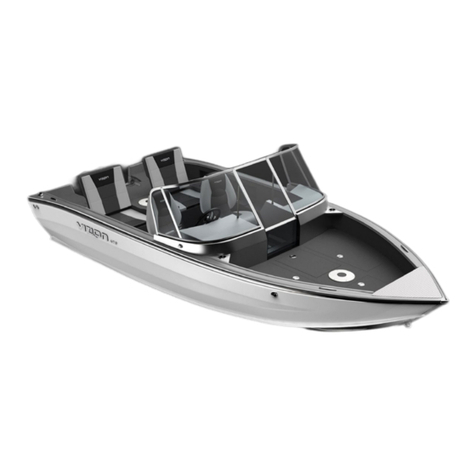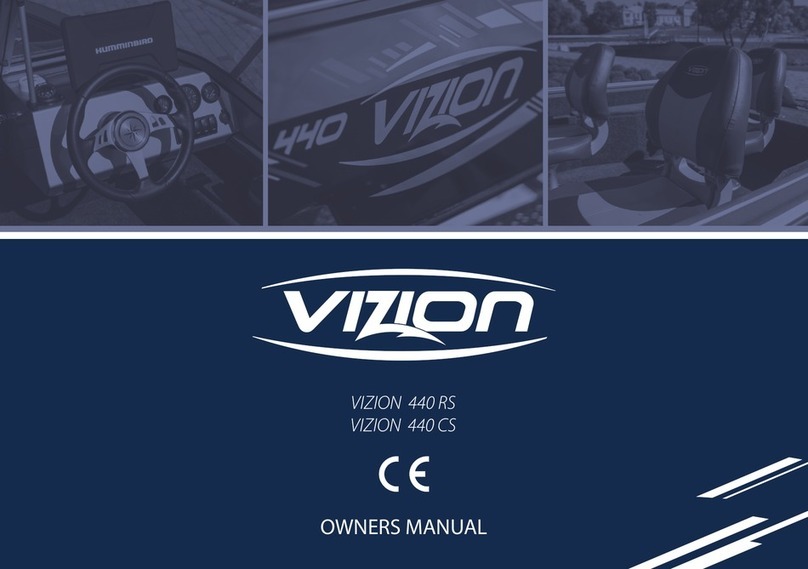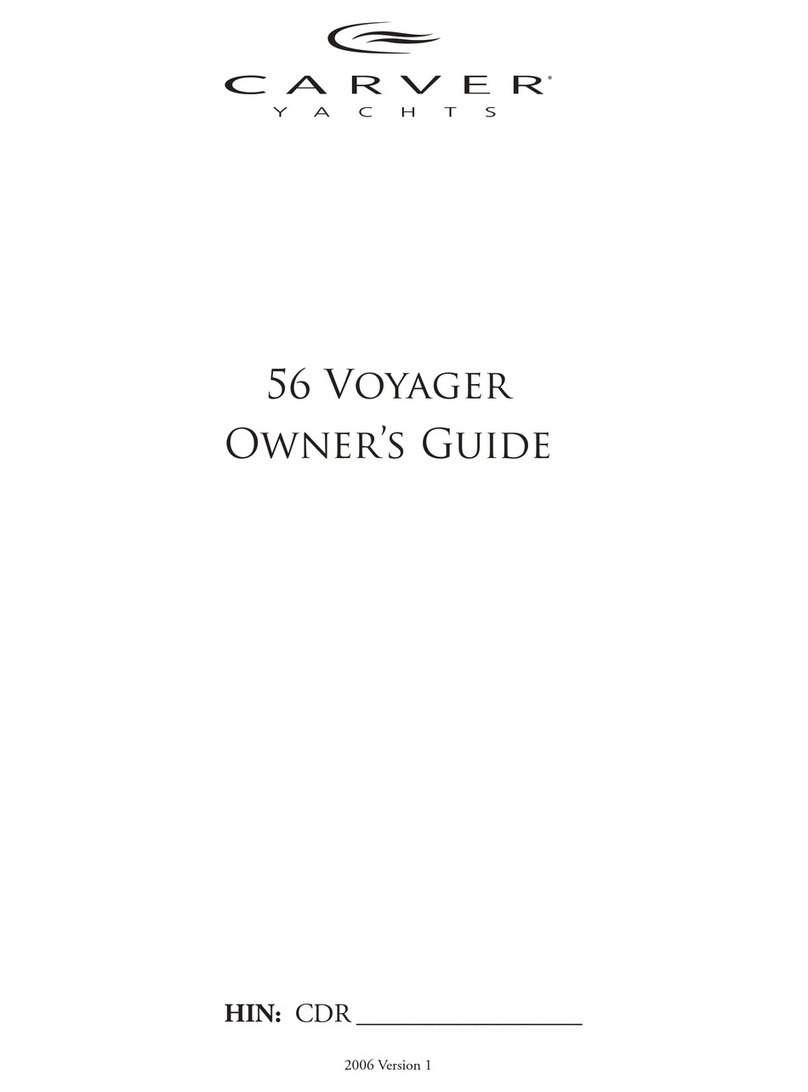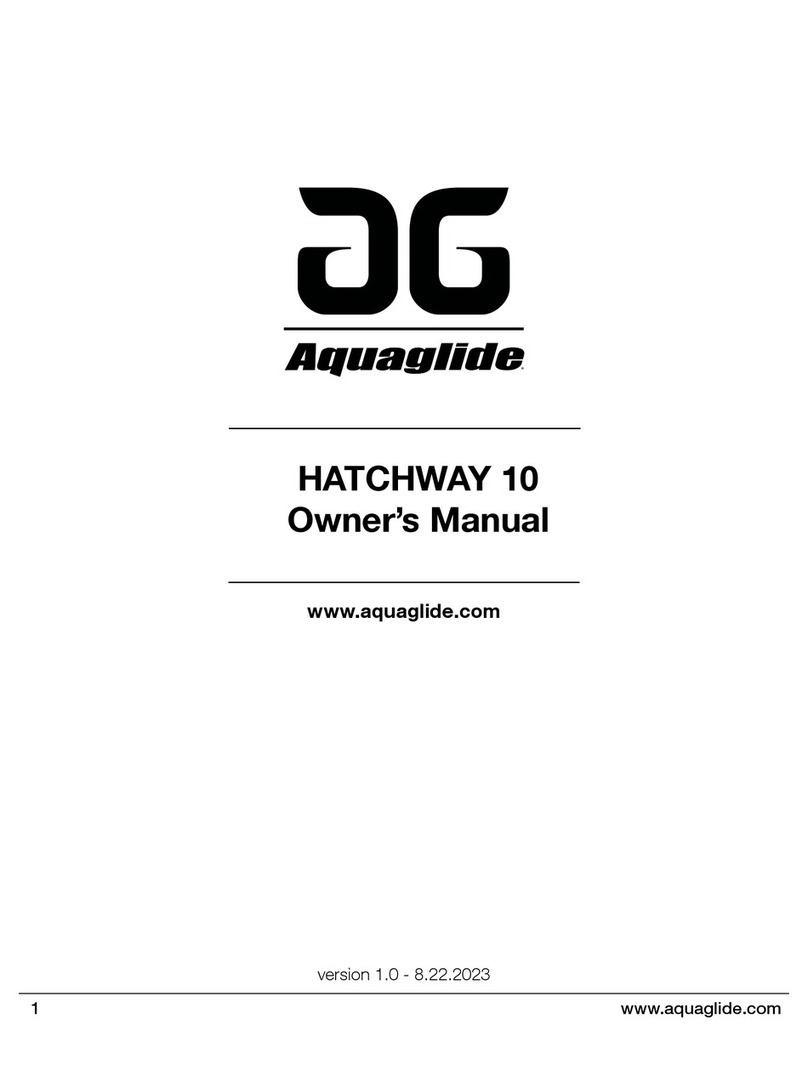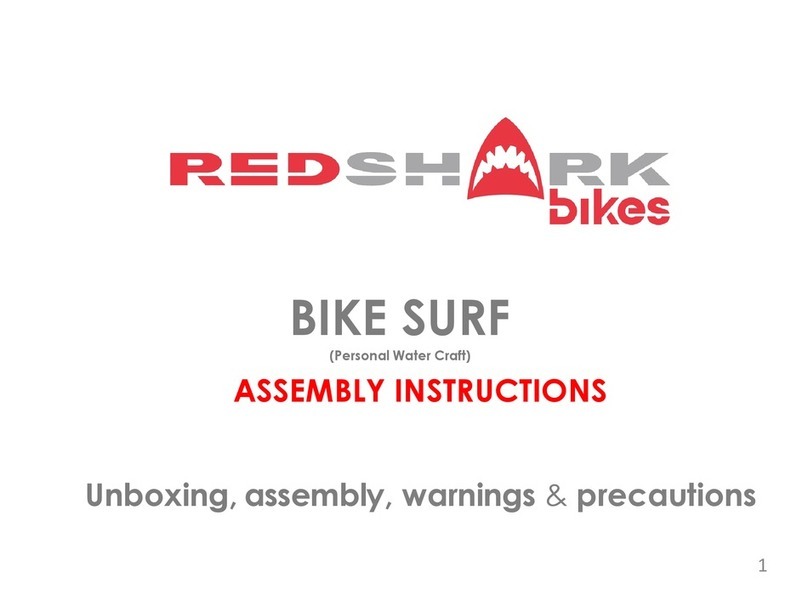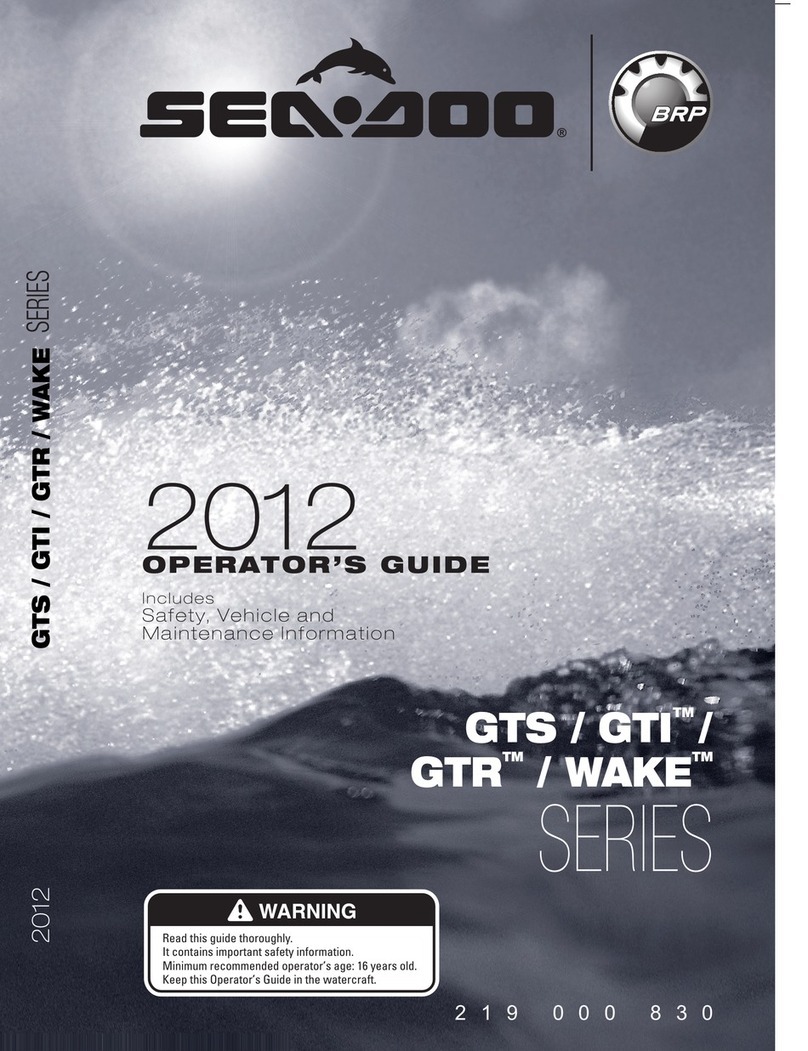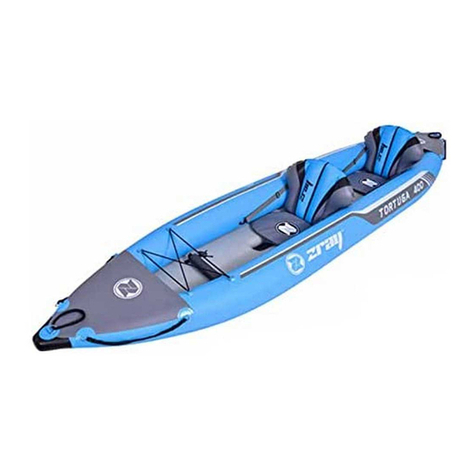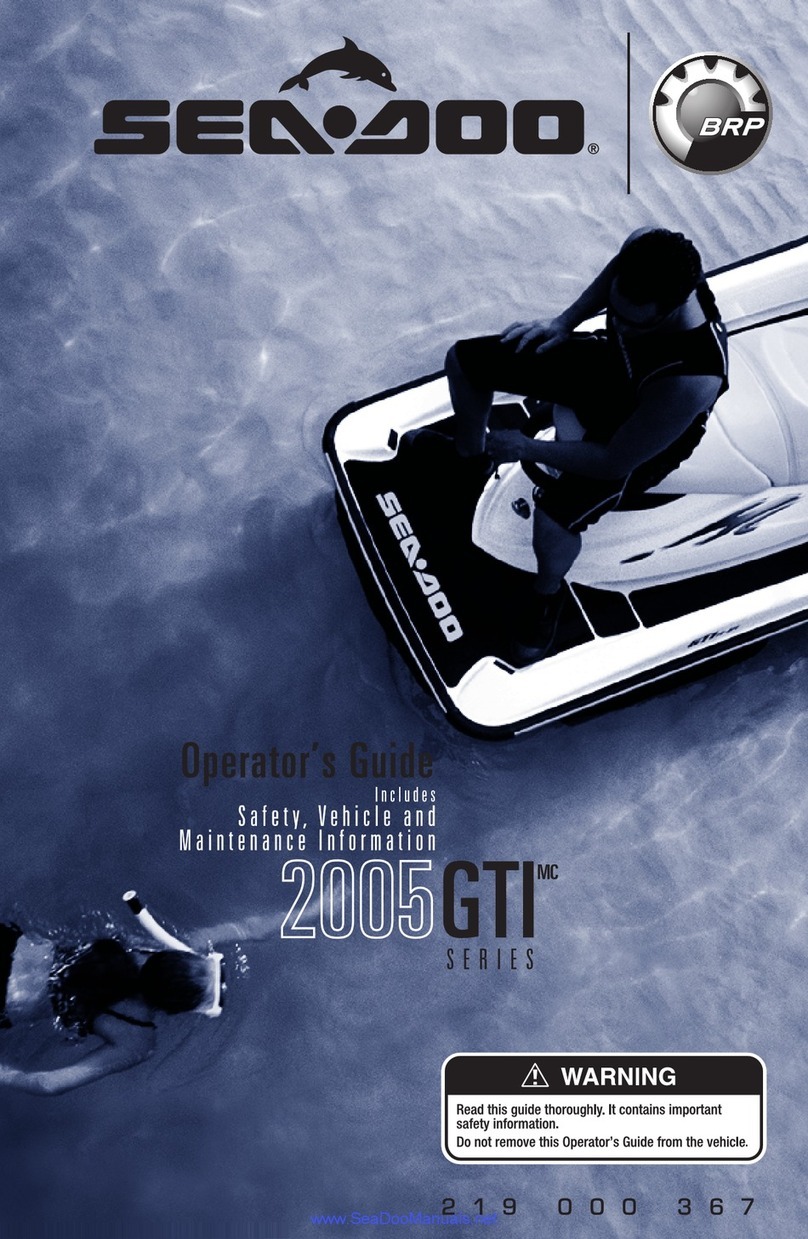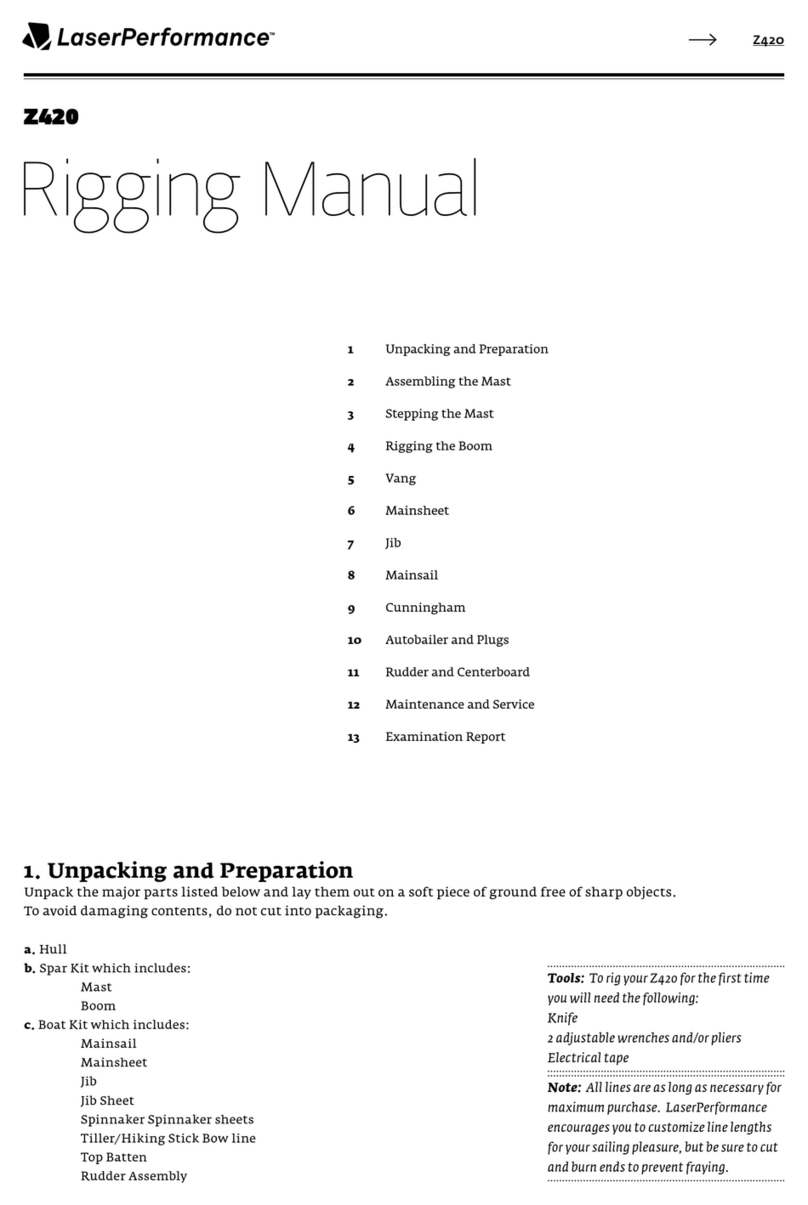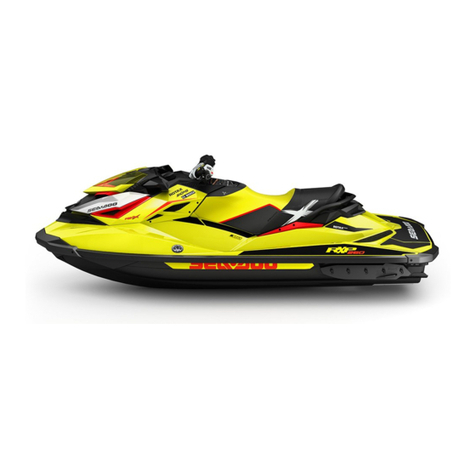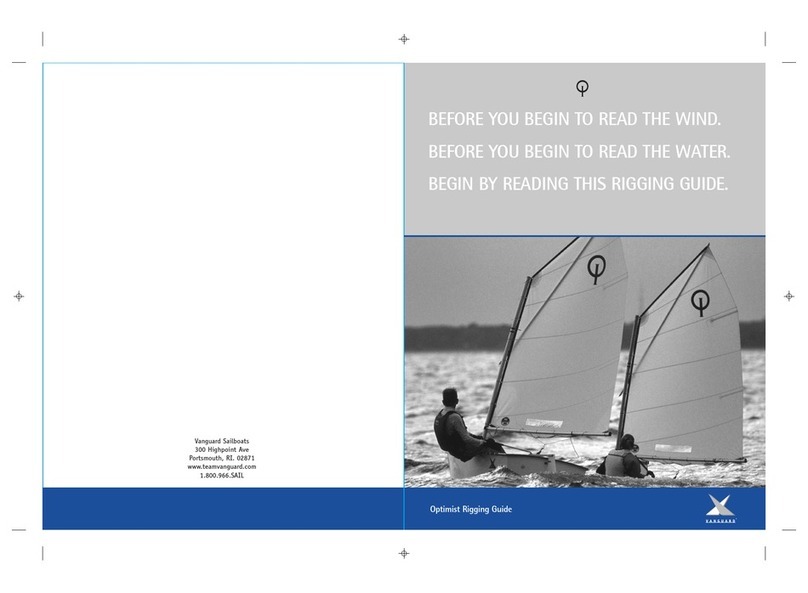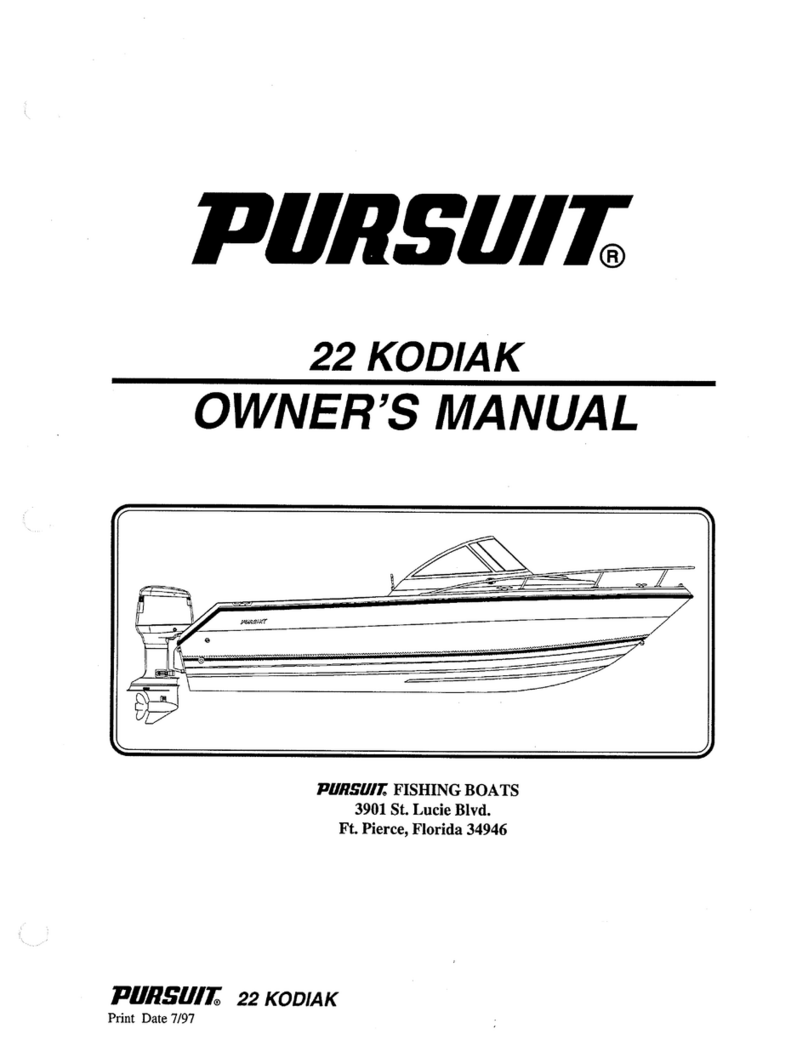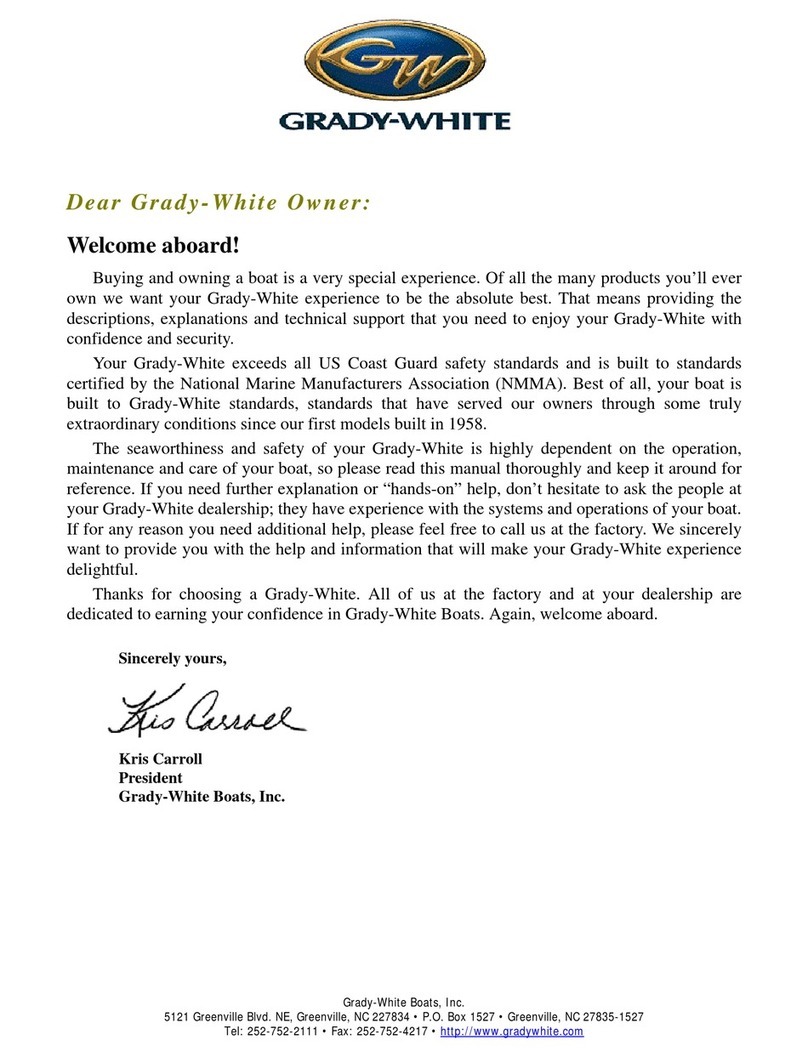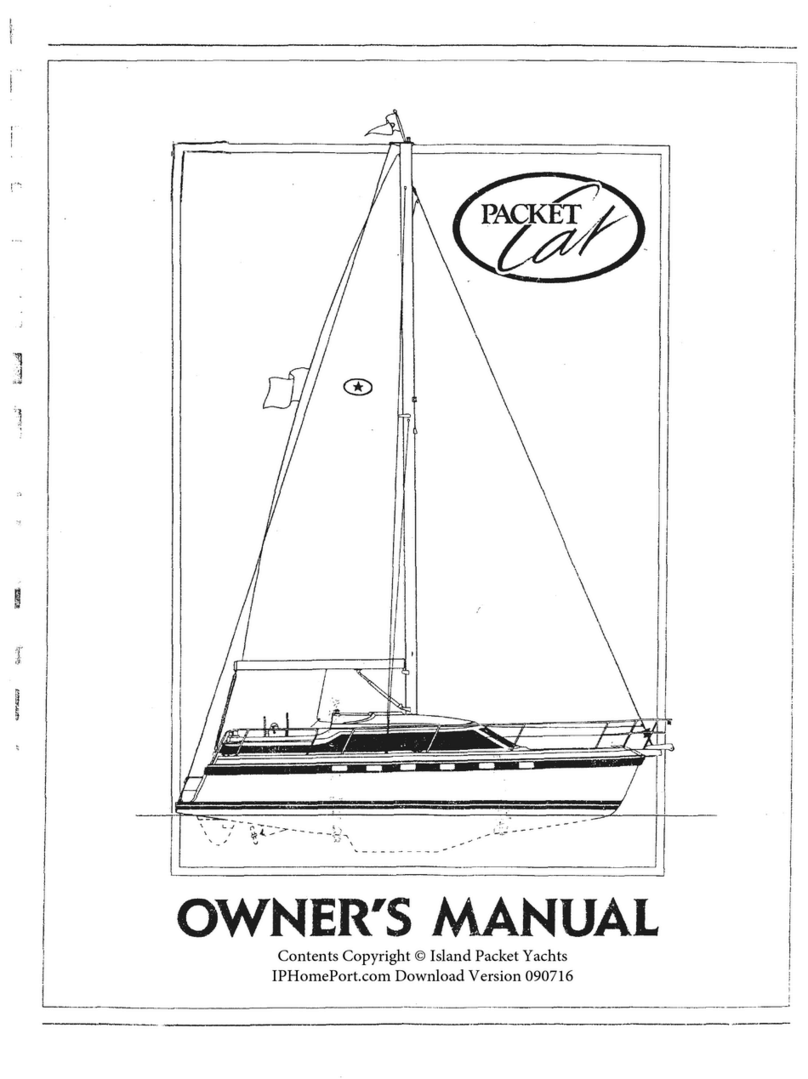Vizion 440 RS User manual

ALUMINUM MOTORBOAT
OWNERS MANUAL BEDIENUNGSANLEITUNG LIETOŠANAS PAMĀCĪBA РУКОВОДСТВО ПО ЭКСПЛУАТАЦИИ
vizboat.com

2

3
EN
CONTENT
1. General guidelines....................................................................................................... 4
2. Technical data................................................................................................................. 4
3. Delivery set........................................................................................................................ 5
4. Hull structures ................................................................................................................ 5
4.1. Basic parameters of hull.......................................................................................... 6
5. Steering and power supply system.................................................................. 6
6. Electrical equipment.................................................................................................. 7
7. Engine installation instructions.......................................................................... 9
8. Safety requirements................................................................................................... 9
9. Transportation and storing.................................................................................... 11
10. Environmental protection...................................................................................... 11
11. Technical maintenance............................................................................................ 11
12. Disposal............................................................................................................................... 11
13. Manufacturer’s guarantee...................................................................................... 12
MOTORBOAT
OWNERS MANUAL

4
EN
1. GENERAL GUIDELINES
Motorboat VIZION 440 RS (hereinafter – boat) is intended for operation
in freshwater and seawater in temperate and cold climates at water
temperature from +5 to +30 degrees Celsius, coastal waters, bays, lakes
and large rivers where the wind force does not exceed 6 (≤ 10,8 m/s),
and wave height does not reach 2 meters.
The boat is intended for tourism journeys, recreation on water, fishing,
hunting, transportation of household and domestic cargos. Represent-
atives of various inspectorates can use the boat for patrolling, econom-
ic purposes, transporting people and as work trip boats.
Boat construction is provided for installation of an outboard engine
(hereinafter in the text – OE).
2. TECHNICAL DATA
Total length, mm 4430
Total width, mm 1870
Side height in the middle, mm 800
Transom height, mm 510
Category C
Hull material 5083 H111
Deadrise angle at transom 10°
Maximum carrying capacity
(mass of passengers and baggage), kg 450
Passenger capacity, persons 4
OE power rating, hp 50
Maximum weight of an engine, kg 161.7
Hull mass with equipment (without OE), kg 290

5
EN
3. DELIVERY SET
Boat delivery set includes:
• boat (without outboard engine);
• owners manual.
4. HULL STRUCTURES
The hull has a distinctly pointed bottom of the bow along with the
longitudinal redans and splash guards ensuring high dynamic perfor-
mance indicators.
The hull of the boat is made of aluminium-magnesium alloy 5083 H111
(or its analogue).
The hull structures in general are connected by electric arc welding in
an inert gas atmosphere.
The hull structures guarantee durability and safety of the boat, which is
reinforced by longitudinal and transversal stringers for reinforcement
built into the bottom and sides of the boat.
The free space under the deck is filled with polyurethane foam, which
ensures excellent buoyancy and boat safety in emergency conditions
in accordance with the EU ISO 12217-3: 2017 standard.
The boat is equipped with navigation lights, water pumping system
(electric pump 33 l/min.), mooring cleats, electrical distribution panel
with fuses and battery disconnect switch.
OE shall be installed on a rigid transom reinforced with high-strength
waterproof plywood.
The hull of the boat can be divided into three parts: bow deck, cockpit
and stern deck.
The VIZION 440RS model does not have a console and wind protec-
tion. On the bow deck there are compartments for things and an
aerator. In the cockpit on the sides there are compartments for things,
in the floor there is a compartment for spinning rods. On the aft deck
there are compart-ments for things and a compartment for a service
battery. The decks are made of 12mm waterproof laminated plywood
covered with marine carpet or vinyl.

6
EN
4.1. BASIC PARAMETERS OF HULL
• sheets of hull bottom, transom: 3 mm
• side sheets: 2 mm
• longitudinal and transversal stringers: 3 mm
• longitudinal redans: L-shaped profile 50x30x3
• longitudinal stringers: U-shaped channel 30х50х30х3
Between the transom and the rear bulkhead there is a self-draining
compartment with a built-in gasket aimed at inserting a fuel pipe for
an OE.
At the bottom of the transom there is a built-in water drain hole with a
caprolon plug. It is designed for draining the remnants of water after a
boat is pulled ashore.
5. STEERING AND POWER SUPPLY SYSTEM
The boat is designed for installation of OE, the power of which must
not exceed 50 hp (OE is not included in the delivery set).
Boat steering is performed using OE tiller.
It is possible to install a stationary fuel tank (as an option) with a capac-
ity of 50l at the stern of a boat. If the tank is installed, its filler neck is
located at the back of the boat.
ATTENTION!
If fuel is spilled and gets under the floor in filling process or due
to careless handling, rinse it immediately with water and pump
it out using the on-board pump. Open the hatch in the recess
and ventilate the boat. The guarantee does not apply to the
pump shell damaged by prolonged exposure to fuel.
Considering the high flammability of fuel and its vapours, com-
ply with the fire safety regulations when filling a fuel tank.

7
EN
6. ELECTRICAL EQUIPMENT
Engine starting, lighting, emergency lighting and electrical
equipment are powered by a 12V battery (not included in the
delivery set).
Electrical equipment includes:
• switches;
• sockets for connecting external electrical devices, voltage 12V;
• electric bilge pump;
• electric pump for aerator;
• navigation lights;
• parking light;
• fuel level sensor and indicator;
• battery disconnect switch.
Each power supply system included in the boat’s standard equip-
ment is protected by a 10A fuse. The fuse box is located in the
right rear compartment.
The supply voltage plus is always connected to the battery
disconnect switch and through it – to power the electrical
equipment and OE.
The supply voltage minus is connected to a terminal
isolated from the hull of a boat and further to the electrical
equipment and OE.
The Fuse diagram
21
87
3
9
4
10
5
11
6
12
1. Livewell, 10A
2. Livewell 2 contour, 10A
3. Bilge pump, 10A
4. Running lights, 10A
ATTENTION!
When installing additional electrical equipment and electronics (batteries, chargers, echo sounders, electric motors, etc.) on the boat,
you should contact qualified specialists. It is necessary to completely exclude the possibility of electrical voltage on the hull of the boat.
Incorrect connection can lead to electrical corrosion of the housing and damage to the paintwork. Such damage is not covered by the
warranty and the manufacturer is not responsible for it.
5. Parking light and deck lighting, 10A
6. Spotlights, 10A
7. Right Socket 12V, 10A
8. Left Socket 12V and USB, 10A

12V
USB 12V
FUEL TANK
FUSE HOLDER
NAVIGATION
LIGHTS
FUEL TANK
SENSOR
NAVIGATION
LIGHTS
POWER POST
BILGE PUMP
LIVEWELL FILLING
LIVEWELL DRAINING
BATTERY SWITCH
POWER POST
CONTROL BUTTONS
LIGHT POLE
NAVIGATION
LIGHTS
LIGHT
POLE
LIVEWELL
FILLING
BILGE
PUMP
BATTERY
SWITCH
LIVEWELL
DRAINING
8
EN
The manufacturer is entitled
to make changes in the
boat’s electrical circuit dia-
gram without prior notice.
The wiring diagram of the electrical equipment

9
EN
7. ENGINE INSTALLATION
INSTRUCTIONS
To ensure proper operation of OE, we recom-
mend that an engine and related equipment
is installed by a qualified technician. Improper
installation of OE can result in engine mal-
function, reduced boat control efficiency, loss
of control, and a risk of fire.
If you install OE yourself, follow the instruc-
tions of Outboard Engine Installation Instruc-
tions supplied with it.
The boat structure complies with the safety
requirements stipulated in the Directive
2013/53/EU and ensures safe operation if
the following conditions are met:
• the power of an outboard engine must not
exceed 50 hp;
• peration of a boat is not allowed if wave
height in a water body exceeds 2 m;
• operation of a boat is not allowed if the
specified passenger capacity is exceeded
(4 people);
• do not exceed the specified maximum
load-bearing capacity, taking into account
the mass of passengers and luggage (not
more than 450 kg);
• when filling the outboard engine or fuel
tank with fuel and oil, comply with fire safe-
ty and environmental safety regulations;
• do not walk on the boat or get up from
seats while driving;
• operation of the boat is not allowed without
individual life-saving appliances, quantity
of which matches the number of people in
the boat;
• it is strictly forbidden to be on the bow deck
while driving (faster than 5 km/h);
• it is strictly forbidden to entrust operation
of a motorboat to persons who have no
driving license, as well as to persons under
the influence of alcohol;
• approaching other waterborne crafts and
swimmers speed must be reduced.
WARNING!
Do not try to manoeuver at high speeds
until you have learned the full potential
of the motorboat.
Control steering at all times and never
release the steering wheel. Always warn
the people in the boat before making
any manoeuvers at speed. In normal
weather conditions, you can make a
slight S-turn not slowing down. More
complex manoeuvers are carried out
adjusting engine power. Reduce power,
keep gliding, make a turn. Increase
power and complete the turn to reach
the previous speed.
. SAFETY REQUIREMENTS

10
EN
To ensure safe navigation, the boat owner
definitely has to complete the boat with:
• life jackets (according to the number of
people in the boat).
For additional safety during navigation, it is
required to complete a boat with:
• waterproof means of communication (radio
equipment) that will transmit and receive
information on safety in the seas, including
weather forecasts;
• magnetic compass;
• 2 lifebuoys with search lights as well as
floating anchors and at least 20 m long
ratline;
• 3 red parachute flares;
• 4 white flares;
• 4 red flares;
• thermal protection means (matching the
quantity of people in the boat).
Before you go on a voyage, make sure that:
• the motorboat, engine, batteries are in
good condition;
• navigation lights and bilge pump function
normally;
• there is enough fuel in the fuel tank;
• life jackets and other life-saving appliances
are in the boat;
• boat hull drain plugs and waterproof com-
partment lids are safely closed;
• the anchor, belongings, equipment and
mooring ropes are well fastened.
WARNING!
Before you go on a voyage, make sure
that all people on board are familiar
with the rules of conduct on small
boats, as well as that they are wearing
life jackets and have comfortably taken
the boat seats. Definitely check wheth-
er the rescue and fire safety equipment
is in the boat.
It is forbidden to operate a motorboat with
the following damage:
• holes or wormholes in the hull and clad-
ding (regardless of their location);
• it is difficult to move the steering system
of OE;
• rudder plate or steering components are
damaged;
• there is a fuel leak from tanks or fuel supply
hoses;
• there is observed vibration of engine or
outboard engine, which exceeds the values
specified in the operating documentation.
. SAFETY REQUIREMENTS

11
EN
9. TRANSPORTATION AND STORING
You can transport boats using any
mode of transport complying with the
regulations on carriage of goods by
specific vehicle.
In all cases, secure a boat to a vehicle to
avoid damage.
ATTENTION!
It is forbidden to use trailers that
are not intended for transpor-
tation of boats. Damage to the
hull bottom caused due to such
transportation is not covered by
the boat guarantee.
It is not allowed to store a boat
on the water near high-voltage
lines, near metal berths and
structures, as well as near boats
with a metal hull. It should be
completely excluded from storing
the boat on the water if there
are berths or boats with faulty
electrical equipment nearby.
To protect the boat hull from
galvanic corrosion, the user must
use anodes. The manufacturer
is not responsible for damage
to the boat hull and paintwork
caused by corrosion. The occur-
rence of any type of corrosion is
not covered by the warranty.
During operation, you must carefully
follow the condition of the boat hull
and equipment to prevent damage in
a timely manner. After a voyage, clean
the boat from dirt and, if necessary,
rinse with water, then drain water from
the hull. Before long-term storage, pull
the boat out of water, detect faults and
repair them if any. It is recommended
to store a boat with its keel downwards
in a closed room or under a shed that
protects from precipitation. Storage
in an open environment is acceptable
if the boat is completely covered by a
protective cover.
When leaving a boat in a parking lot,
disconnect the power supply of the
boat’s electrical system using a battery
disconnect switch.
When parking (storage), all electri-
cal equipment of the boat must be
de-energized using the main switch. To
prevent electrical leakage, short circuit
and fire, do not leave the boat unat-
tended with the electrical equipment
turned on. When storing the boat on
the shore, lift it off the ground by plac-
ing keel blocks under it.
10. ENVIRONMENTAL PROTECTION
During operation, all oil product residues, dirty water,
waste (including food leftovers) and substances polluting
the environment must be retained in the boat.
In order to prevent contamination of water bodies with oil
products, during the operation of engine it is required:
to check the condition of the fuel system connections
periodically and repair damage immediately if there is a
fuel leak detected. If it is impossible to repair the damage
to the fuel system while the engine is operating, stop the
engine, find out cause of the damage and take action to
prevent fuel from getting into the water body.
11. TECHNICAL MAINTENANCE
After each use, visually inspect the boat for any potential
damage, inspect all fuel and electrical system units, make
repairs and prevent any damages if necessary. All repair,
diagnostic and maintenance work must be carried out in a
certified service by qualified specialists.
12. DISPOSAL
A boat which is not suitable for further operation must be
disposed of. The owner of the boat is responsible for its
disposal. Disposal of the boat must be carried out in spe-
cially equipped places intended for it. In both regular and
emergency conditions, ensure safety and health of people
when disposing of boat.

12
EN
The boat warranty period is listed on the last
page of this owner’s manual. During the guar-
anty period, the manufacturer shall repair the
boat free of charge or replace the boat if it has
a marking plate, as well as if the boat’s owners
manual is presented and all operating, trans-
port and storage regulations are observed.
WARNING!
The manufacturer shall not compen-
sate and be liable for defects caused as
a result of user’s or trader’s fault, negli-
gent transportation, improper storage
and operation, mechanical damage to
the boat, and non-compliance with the
requirements of this owners manual.
The manufacturer shall not be liable for any
consequences, including damage caused to
third parties, resulting from non-compliance
with the boat operation, transport or storage
conditions when the boat is used for purposes
other than the intended and any changes to
the boat structures or equipment without
agreement with the manufacturer.
Any changes to the boat structures or equip-
ment, as well as elimination of any damage or
malfunctions that occurred, must be agreed
with the manufacturer in writing. Failing to do
so the consumer will lose the right to guaran-
tee service.
13. MANUFACTURER’S GUARANTEE ACCEPTING
THE READY PRODUCT
Before each motorboat is handed over to a
buyer, there is an acceptance control check-
ing: appearance, quality of outer surfaces,
quality of welding seams, as well as assembly.
IN CASE YOU NEED GUARANTY
REPAIR, OUR ADDRESS IS:
5A Stradnieku skersiela,
Rezekne, LV-4604, Latvia
T: +371 294-197-09 | vizboat.com
By that we, “FISHBOAT RSEZ” LLC, 5A
Stradnieku skersiela, Rezekne, LV-4604, Latvia
confirm that CE Certification was performed
in accordance with Directive 2013/53/EU.

13
DE
INHALT
1. Allgemeine Hinweise.....................................................................................14
2. Technische Daten.............................................................................................14
3. Lieferset...................................................................................................................15
4. Rumpfkonstruktion .......................................................................................15
4.1. Basisparameter des Rumpfs.....................................................................16
5. Steuerungs- und Stromversorgungssystem.................................16
6. Elektrische Ausstattung...............................................................................17
7. Anleitung zur Installation des Motors ...............................................19
8. Sicherheitsanforderungen......................................................................... 19
9. Transport und Lagerung .............................................................................21
10. Umweltschutz..................................................................................................... 21
11. Wartung.................................................................................................................. 21
12. Entsorgung ..........................................................................................................21
13. Herstellergarantie.............................................................................................22
BEDIENUNGSANLEITUNG
MOTORBOOT

14
DE
1. ALLGEMEINE HINWEISE
Das Motorboot VIZION 440 RS (nachfolgend das Boot genannt) ist
für den Betrieb in Süß- und Meerwasser in gemäßigten und kalten
Klimazonen vorgesehen, wo die Lufttemperatur, in Küstengewässern,
Buchten, Seen und großen Flüssen bei Wassertemperatur von +5 bis
+30 Grad Celsius und die Windstärke 6 BFT (≤ 10,8 m/s), die Wellenhö-
he aber 2 Meter nicht überschreitet.
Dieses Boot ist für Ausflüge, Erholung auf dem Wasser, Angeln, Jagd,
Beförderung von Haushaltsfrachten ausgelegt. Das Boot kann von
Vertretern unterschiedlicher Aufsichtsbehörden gebraucht werden,
um Patrouillen auf dem Wasser durchzuführen, als Personentransport
und als Arbeitskutter sowie zu wirtschaftlichen Zwecken eingesetzt
werden.
Die Konstruktion des Bootes ist zum Einbau eines Außenbordmotors
(nachfolgend AM genannt) vorgesehen.
2. TECHNISCHE DATEN
Länge, mm 4430
Breite, mm 1870
Seitenhöhe in der Mitte, mm 800
Heckspiegelhöhe, mm 510
Kategorie C
Rumpfmaterial 5083 H111
Heckwinkel 10°
maximales Traggewicht
Gewicht von Passagieren und Gepäck), kg 450
maximale Anzahl an Personen 4
maximal zulässige Motorleistung, PS 50
maximal zulässiges Motorgewicht, kg 161.7
Rumpfgewicht samt Ausrüstung (ohne AM), kg 290

15
DE
3. LIEFERSET
Das Lieferset des Boots besteht aus:
• einem Boot (ohne AM);
• einer Bedienungsanleitung.
4. RUMPFKONSTRUKTION
Der Rumpf des Boots hat am Bug deutlich scharfe Umrisse, die in Ver-
bindung mit den Längsprofilen und Fender gegen Wellenbildung und
Spritzen hohe dynamische Eigenschaften gewährleisten können.
Der Rumpf des Bootes ist aus einer Legierung 5083 H111 von Aluminium
und Magnesium (ggf. ihrer Nachbildung) hergestellt.
Als Vorgehensweise zur Verbindung von Rumpfstrukturen dient vorwie-
gend das Lichtbogenschweißen in einer Atmosphäre aus Zwischengas.
Die Festigkeit und Sicherheit des Boots wird durch seine Rumpfkonst-
ruktion gewährleistet, die anhand von eingebauten Längs- und Querver-
stärkungsrippen am Boden-, Deck- und im Seitenbereich verstärkt ist.
Der Freiraum unter dem Deck ist mit Polyurethanschaum gefüllt, der im
Fall der Notsituation einen hervorragenden Auftrieb, eine Unsinkbarkeit
und Bootssicherheit gemäß Standard EU ISO 12217-3: 2017 gewährleistet.
Das Boot ist mit Navigationslichtern, einem Wasserpumpsystem (Elekt-
ropumpe 33l/min), den Festmacherklemmen, einem Sicherungskasten
und einem Trennschalter ausgestattet.
AM wird auf einer festen Wasserrutsche installiert, die durch eine hoch-
feste wasserdichte Sperrholzplatte verstärkt ist.
Der Rumpf des Bootes lässt sich in drei Teile unterteilen: das Bug, das
Cockpit und das Achtercockpit.
Das Modell VIZION 440RS hat keine Konsole und keine Windschutzschei-
be. Auf dem Bugdeck gibt es Fächer für Dinge und einen Belüfter. Im
Cockpit an den Seiten befinden sich Fächer für Dinge, im Boden befindet
sich ein Fach für Spinnruten. Auf dem Achterdeck befinden sich Fächer
für Sachen und ein Fach für eine Servicebatterie. Die Decks bestehen aus
12 mm wasserdichtem, laminiertem Sperrholz, das mit Marineteppich
oder Vinyl bedeckt ist.

16
DE
4.1. BASISPARAMETER DES RUMPFS
• Bodenbeschichtung, Heck: 3 mm
• Seitenbeschichtung: 2 mm
• Längs- und Querverstärkungsrippen: 3 mm
• Längsfender: L-Profil 50x30x3
• Längsverstärkungsrippen: U-Profilträger 30х50х30х3
Hinter dem Energieversorgungsschott befindet sich selbstentleeren-
des Wasserrückgangsfach mit einem eingebauten Flansch für AM
Kraftstoffleitung.
Am unteren Teil des Hecks ist Wasserablaufloch mit einem Stopfen aus
Kaprolon eingebaut. Es dient zum Ablassen der Wasserreste, nachdem
das Boot an Land gezogen ist.
5. STEUERUNGS- UND STROMVERSORGUNGSSYSTEM
Das Boot ist für den Einbau von AM bis zur Leistung von 50 PS nicht
ausgelegt (AM ist nicht im Lieferumfang enthalten).
Das Boot wird mithilfe einer AM Pinne gesteuert.
Es ist möglich, am stationären Kraftstofftank Heck (als Zusatzausstat-
tung) mit dem Volumen von 50l einzubauen. Wenn der Tank einge-
baut ist befindet sich sein Einfüllstutzen am Heck des Boots.
ACHTUNG!
Sollte während des Auftankens oder nach einem unachtsamen
Umgang mit Kraftstoffbehältern unter den Boden oder in die
Kisten geraten, waschen Sie es sofort mit Wasser und lassen Sie
das Wasser umgehend mit einer vorhandenen Pumpe absau-
gen. Öffnen Sie die Rezessionslücke und entlüften Sie das Boot.
Die Garantie gilt nicht, wenn das Pumpengehäuse aufgrund
längerer Einwirkung von Kraftstoff geschmolzen ist.
Mit Rücksicht auf die hohe Entflammbarkeit von Kraftstoff und
dessen Dämpfen sind beim Betanken die Brandschutzvorschrif-
ten zu beachten.

17
DE
6. ELEKTRISCHE AUSSTATTUNG
Anlassen des Motors, Beleuchtung, Notbeleuchtung, Stromver-
sorgung der elektrischen Verbraucher erfolgt aus einem Akku mit
einer Spannung von 12V (nicht im Lieferumfang enthalten).
Elektrische Ausstattung hat:
• Schalter;
• Steckdosen für elektrische Außenanlagen, Spannung 12V;
• elektrische Pumpe;
• elektrische Pumpe für einen belüftungsartigen Fischbehälter;
• Navigationslicht;
• Standlicht;
• Kraftstoffstandsensor und Kraftstoffanzeige (optional);
• Massenschalter.
Die Stromversorgung der Standardausrüstung des Boots wird
durch eine Schutzverriegelung 10A gesichert. Der elektrische
Verteilerkasten befindet sich samt Sicherungen im rechten Fach
am Heck.
Die Spannung der Stromversorgung „+“ ist immer an den
Massenschalter angeschlossen – zur Versorgung von elekt-
rischen Anlagen und AM.
Die Spannung der Stromversorgung „-“ ist immer vom
Rumpf aus zum isolierten Pol – Zapfen angeschlossen und
weiter zu elektrischen Anlagen und AM.
Sicherungsdiagramm
21
87
3
9
4
10
5
11
6
12
1. Livewell, 10A
2. Livewell 2 contour, 10A
3. Bilge pump, 10A
4. Running lights, 10A
ACHTUNG!
Beim Einbau zusätzlicher elektrischer und elektronischer Geräte in das Boot (Batterien, Ladegeräte, Echolote, Elektromotoren usw.)
sollte ein qualifizierter Techniker hinzugezogen werden. Das Eindringen elektrischer Spannungen in den Bootskörper muss zu jeder Zeit
verhindert werden. Falsche Anschlüsse können zu elektrischer Korrosion am Rumpf und zu Schäden an der Lackierung führen. Solche
Schäden sind nicht von der Garantie abgedeckt und der Hersteller ist nicht dafür verantwortlich.
5. Parking light and deck lighting, 10A
6. Spotlights, 10A
7. Right Socket 12V, 10A
8. Left Socket 12V and USB, 10A

18
DE
Alle Rechte des Herstellers,
Änderungen am Schaltplan
des Bootes ohne vorherige
Ankündigung einzuführen,
sind vorbehalten.
Der Schaltplan der elektrischen Ausrüstung ist
12V
USB 12V
FUEL TANK
FUSE HOLDER
NAVIGATION
LIGHTS
FUEL TANK
SENSOR
NAVIGATION
LIGHTS
POWER POST
BILGE PUMP
LIVEWELL FILLING
LIVEWELL DRAINING
BATTERY SWITCH
POWER POST
CONTROL BUTTONS
LIGHT POLE
NAVIGATION
LIGHTS
LIGHT
POLE
LIVEWELL
FILLING
BILGE
PUMP
BATTERY
SWITCH
LIVEWELL
DRAINING

19
DE
7. ANLEITUNG ZUR
INSTALLATION DES MOTORS
Es ist empfehlenswert, den Motor und dazu-
gehöriges Zubehör von einer Fachperson
installieren zu lassen, um korrekte Aufstellung
und normalen Betrieb des AM sicherzustellen.
Eine unsachgemäße Installation kann die
Effizienz der Bootssteuerung beeinträchtigen
sowie Kontrollverlust und Feuer verursachen.
Sollten Sie den AM selbst installieren, folgen
Sie bitte den hinzugefügten Anweisungen
(„Handbuch zur Installation eines Außenbord-
motors“).
Die Konstruktion des Boots entspricht den
Sicherheitsanforderungen laut Richtlinie
2013/53/EU und garantiert einen sicheren
Betrieb, soweit folgende Bedingungen er-
füllt sind:
• die Leistung des AM darf nicht die Kenn-
zahl von 50 PS überschreiten;
• der Bootsbetrieb ist in Gewässern bei Wel-
lenhöhen über 2 m strengstens verboten;
• die maximal empfohlene Anzahl von Perso-
nen (4 Pers.) darf nicht beim Bootsbetrieb
überschritten werden;
• maximales Traggewicht unabhängig von
der Anzahl der Personen an Bord und das
Gesamtgewicht von Ausrüstung dürfen nie
die zugelassene Zuladung überschreiten
(max. 450 kg);
• beim Betanken des AM oder Kraftstofftanks
mit Kraftstoff oder Öl sind die Vorschriften
für Brandschutz und Umweltsicherheit zu
beachten;
• die Bewegungen an Bord bzw. das Verlas-
sen der Sitzplätze während der Fahrt sind
strengstens verboten;
• der Bootsbetrieb ohne individuelle Ret-
tungsausrüstung für jede Person an Bord
ist nicht gestattet;
• es ist strengstens verboten, sich während
der Fahrt (mehr als 5 km/h) im Bugcockpit
zu befinden;
• es ist strengstens untersagt, die Leitung
eines Motorboots Personen, die keinen
Führerschein besitzen, und Personen, die
unter Alkoholeinfluss stehen, anzuver-
trauen;
• bei der Annäherung an andere Wasserfahr-
zeuge und Schwimmer ist die Geschwin-
digkeit unbedingt herabzusetzen.
WARNUNG!
Trauen Sie sich lieber kein Manövrie-
ren mit hoher Geschwindigkeit, bis
Sie Funktionen Ihres Motorboots nicht
überprüft haben.
Steuern Sie ständig die Lenkung, lassen
Sie das Lenkrad niemals los. Infor-
mieren Sie jeweils Personen an Bord,
bevor Sie irgendwelche Manöver mit
Geschwindigkeit ausführen möchten.
Unter normalen Wetterbedingungen
können Sie eine einfache S-Kurve ma-
chen, ohne Geschwindigkeit zu verrin-
gern. Eine anspruchsvollere Zirkulation
wird durch Einstellen der Motorleistung
erreicht. Reduzieren Sie zuerst die Leis-
tung ohne Gleitverlust zu verursachen,
biegen Sie dann ab. Erhöhen Sie die
Leistung und beenden Sie danach die
Kurve, um aktuelle Geschwindigkeit zu
erreichen.
. SICHERHEITSANFORDERUNGEN

20
DE
Der Bootsbesitzer ist verpflichtet, sichere
Navigation zu gewährleisten und das Boot
mit folgender Ausrüstung unbedingt aus-
zustatten:
• Schwimmwesten (gemäß Anzahl der Per-
sonen an Bord).
Für Sicherheit beim Segeln im Meer sollte
das Boot mit zusätzlicher Ausrüstung aus-
gestattet sein:
• wasserdichte Kommunikationsgeräte
(Radio) zum Senden und Empfangen von
Information zur Sicherheit im Seeverkehr,
einschließlich Wettervorhersage;
• Magnetkompass;
• 2 Rettungsringe mit Suchscheinwerfern
sowie einem schwimmenden Anker und
einer Schleppleine von mindestens 20m;
• 3 rote Fallschirmraketen;
• 4 weiße Signalraketen;
• 4 rote Signalraketen;
• Wärmeschutzausrüstung (je nach Anzahl
der an Bord vorhandenen Personen).
Bevor Sie einen Ausflug machen, vergewis-
sern Sie sich, dass:
• Motorboot, Motor, Batterien in einem guten
technischen Zustand sind;
• die Navigationslichter und die Pumpe gut
funktionieren;
• im Kraftstofftank genug Kraftstoff ist;
• Schwimmwesten und andere lebensretten-
de Geräte dabei sind;
• alle Ablassschrauben und Ventile des
Rumpfs und der wasserdichten Fächer fest
verschlossen sind;
• der Anker, die Sachen und die Festma-
cherseile an der Seite des Motorbootes
angebracht sind.
WARNUNG!
Vergewissern Sie sich vor dem Ausflug,
dass alle Personen an Bord mit den
Verhaltensregeln für das Motorboot ver-
traut sind, sowie mit Schwimmwesten
ausgestattet sind und sich bequem in
den Bootssitzen befinden. Prüfen Sie die
Rettungs- und Brandschutzausrüstung,
die müssen unbedingt an Bord sein.
Es ist verboten, das Motorboot mit folgen-
den Störungen zu betreiben:
• Löcher an Rumpfgehäuse und Beschädi-
gung in der Beschichtung (unabhängig
von der Stelle);
• die Bewegung der AM-Steueranlage des
Boots ist eingeschränkt;
• Beschädigte Lenkplatte oder Teile am
Lenkgetriebe;
• Austreten des Kraftstoffs aus Tanks und
Schläuchen im Versorgungssystem;
• Merkmale der Schwingungen am Motor
und Außenbordmotor, die entsprechende
Werte, angegeben in der Betriebsdoku-
mentation, überschreiten.
. SICHERHEITSANFORDERUNGEN
Other manuals for 440 RS
1
Table of contents
Languages:
Other Vizion Boat manuals
